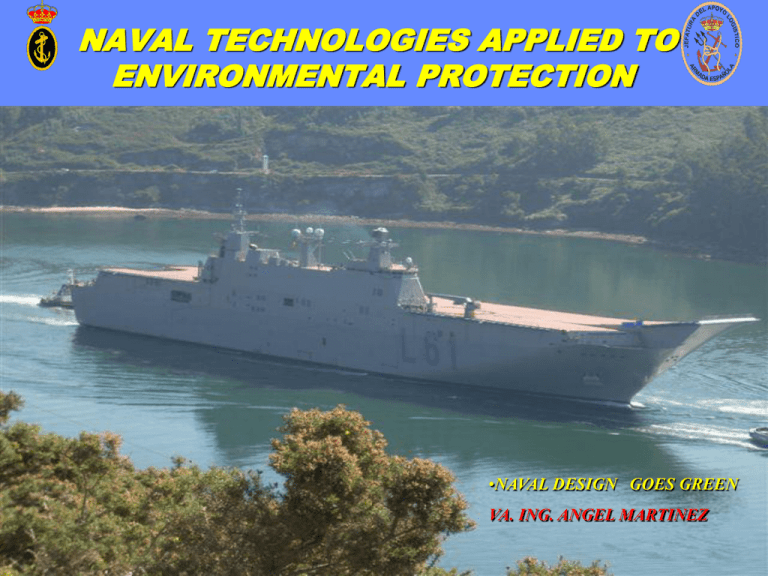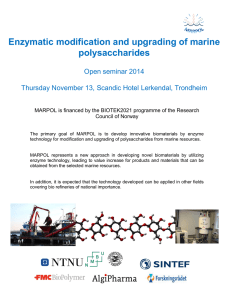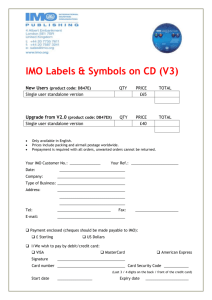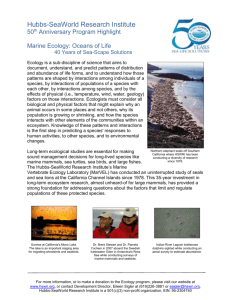Angel Martinez
advertisement

NAVAL TECHNOLOGIES APPLIED TO ENVIRONMENTAL PROTECTION •NAVAL DESIGN GOES GREEN VA. ING. ANGEL MARTINEZ CONTAMINATION OF THE SEA • The sea, one of the basic elements of the environmental balance on this planet, is under serious risk as a result of the pollution . • An important part of the contamination has its origin in ships. • Ships are enforced to fulfil certain rules to prevent pollution. These rules must procure to minimize the marine contamination. The Mediterranean is a sick sea, where it takes around 100 years for the waters to become renewed. (Mediterranean Sea Conference - Tunisia 1995) IMO REGULATIONS INTERNATIONAL MARITIME ORGANIZATION IMO MARITIME POLLUTION CODE & AMENDMENTS MARPOL 73/78 4 MARPOL CONVENTION 73/78 • ADOPTED AT IMO AS A COMBINATION OF TWO TREATIES OF 1973 AND 1978. ENTERED INTO FORCE IN 1983. UPDATED BY AMENDMENTS THROUGH THE YEARS. • SPAIN RATIFIES IN 1979 AND GOES INTO EFFECT IN 1983. • APPLICABLE TO ALL KIND OF SHIPS EXCEPT WARSHIPS. • INCLUDES SIX TECHNICAL ANNEXES. • STATES PARTIES MUST ACCEPT THE TWO FIRST ANNEXES, THE OTHER ARE VOLUNTARY. IMO IMO REGULATIONS MARPOL Article 3.3., “This Convention does NOT apply to WARSHIPS, naval auxiliary or other ships operated by a State and used only for government non-commercial services”. 6 SPANISH M.O.D. NORMATIVE • MINISTRY OF DEFENSE DIRECTIVE 01/92. • MINISTRY OF DEFENSE DIRECTIVE 107/97 - ESTABLISHES ENVIRONMENTAL POLICY. - DEFINES THE DIGENIN COMPETENCE. - SUSTAINABLE DEVELOPMENT. - SUSTAINABLE OPERATIVITY. - ESTABLISHES ENVIRONMENTAL MANAGEMENT SYSTEMS. (MANDATORY FOR THE ARMED FORCES). • SECRETARY OF DEFENSE INSTRUCTION 30/98 (DEVELOPS DIRECTIVE 107/97). - ESTABLISHES A PERMANENT ORGAN OF WORK. - ESTABLISHES POLICY: LEGISLATION AND ENVIRONMENTAL RECOVERING. IMO MARPOL 73/78 INCLUDE SIX TECHNICAL ANNEXES Regulations for the Prevention of Pollution by: • Annex I: FUEL / OIL . • Annex II: NOXIOUS LIQUID SUBSTANCES IN BULK (Such as Chemicals). • Annex III: HARMFUL SUBSTANCES CARRIED BY SEA IN PACKAGED FORM. • Annex IV: SEWAGE FROM SHIPS. • Annex V: GARBAGE FROM SHIPS. • Annex VI: AIR POLLUTION FROM SHIPS (Complemented with the Kioto Convention and Montreal Protocol). 8 •MARPOL CONVENTION 73/78 • MARPOL establishes also some Special Areas where it is absolutely forbidden to discharge hydrocarbons, plastics and solids in general. The discharge of residual black waters is not permitted inside restricted waters and the discharge of grey waters depends on the criteria of the local authorities. Also it is not permitted the discharge of food residues at less than 12 miles from the shore. These special areas are: • • • • • • • • Mediterranean Sea. Baltic Sea. Black Sea. Red Sea. Persian Gulf. North Sea. Antarctic Ocean. Caribbean Sea. The Antarctic Ocean is one of the Special Areas established by MARPOL •TREATMENT OF RESIDUES THE TOTAL AMOUNT OF RESIDUES GENERATED IN A SHIP IS IMPORTANT. Example: Ship LHD “J.C. I” with a capacity for 1.440 persons. *Residues generated = 257m3 per day * Residues generated in a mission of 50 days= 12.850 m3 Not possible... Store. Is required... Collect .. Process..Elimination. Following directions of the International Organizations...IMO and Local Authorities. TREATMENT OF RESIDUES DISTRIBUTION OF RESIDUES DAILY GENERATED BY ONE LHD TYPE SHIP OILY WATERS 16.000 L BLACK AND GREY WATERS COMBUSTIBLE SOLIDS 224.000 L 14.300 L NON COMBUSTIBLE SOLIDS 2.000 L FOOD RESIDUES 1.200 L 257.500 L 715 L 0 0 320 L 350 L 45 L 0,3 % MARPOL 73/78 IMO Annex I. Prevent Pollution by FUEL / OIL. Ships must be fitted with equipment: Oily-water separators, filtering system, oildischarge monitoring system, slop tanks, sludge tanks and pumping. Hydrocarbons in water limited to 15 ppm. 12 APPLICATION OF MARPOL INTEGRATED WASTE MANAGEMENT SYSTEM IN F-105 (UNDER CONSTRUCTION): - ANNEX I. TO PREVENT POLLUTION BY FUEL /OIL. • OILY WATER INDICATOR • BILGE WATER-OIL SEPARATOR • 12 OIL STORAGE TANKS. 13 MARPOL 73/78 IMO Annex IV: Prevention of SEWAGE from ships. GREY WATERS: . FREE DISCHARGE ALLOWED. BLACK WATERS DISCHARGES: • TREATED: > 3 n.m. • NOT TREATED: > 12 n.m. EFFLUENTS: . BOD5 < 25 mg/l . T.S.S. < 35 mg/l . COLIFORMS < 100 col/100ml THE TREND IS TO TREAT ALSO GREY WATERS AS S.N. DOES. 14 F-105. MARPOL APPLICATION • ANNEX IV. SEWAGE. 2 SEWAGE & GREY WATER TREATMENT PLANTS. 5 WASTE GREY WATER HOLDING TANKS. 15 MARPOL APPLICATION ANNEX V. PREVENT POLLUTION BY GARBAGE SOLID WASTE TREATMENT SYSTEM IN F-105. • NON COMBUSTIBLE INORGANIC SOLID WASTE: TRASH COMPACTOR 1. • COMBUSTIBLE INORGANIC SOLID WASTE: TRASH COMPACTOR 2 ->INCINERATOR • ORGANIC GARBAGE: 2 PULPERS . 16 F-105. MARPOL APPLICATION •ANNEX V GARBAGE COMPACTOR ROOM INCINERATOR 17 F-105. RULES APPLICATION •ANNEX VI. PREVENTION OF AIR POLLUTION. • DIESEL ENGINES With MARPOL AIR POLLUTION CERTIFICATE. • FUEL QUALITY. • OZONE DEPLETING SUBSTANCES LIKE HALONS AND CFC´s ELIMINATED ON BOARD. 18 10 9 8 NO,x 7 SO,x 6 5 CO2 4 CO 3 HC 2 Partículas 1 0 DIESEL TURBINA GAS VAPOR Emissions to the atmosphere depending on naval propulsion type WASTE HEAT RECOVERY ► Use of High Efficiency Waste Heat Recovery (WHR) systems Total efficiency of the engine can be increased by more than 5 %. That means less fuel consumption and therefore less emissions to the atmosphere. Requires extensive modifications for existing vessels. UNDER WATER HULL COATING ► IMO Resolution of Nov. 99 called for global prohibition on the application of organotin compounds which act as biocides in antifouling system on ships, by Jan. 2008. ► Application of low friction hull coatings Coatings based on nanotechnologies Silicone paints. THE IMPORTANCE OF ROUGHNESS % FUEL PENALTY vs. INCREASED ROUGHNESS 12.0% 10.0% 8.0% 6.0% 4.0% 2.0% “Fuel Economy due to Improvement in Ship Hull Surface Condition” 00 0 Roughness (microns) 10 95 0 90 0 85 0 80 0 75 0 70 0 65 0 60 0 55 0 50 0 45 0 40 0 35 0 30 0 25 20 0 0.0% SILICONE ANTIFOULING PAINTS F-101 IN DRY DOCKING IN FERROL “Alvaro de Bazán” F101: Painted in Ferrol in Nov. 06 IMO IMO REGULATIONS FUTURE LEGISLATION: BALLAST WATER 25 CLASSROOM FOR TREATMENT OF RESIDUES GREEN PASSPORT (I) •Resolution A.962 IMO GUIDELINES ON SHIP RECYCLING • The use of hazardous materials should be minimized in the design, construction and maintenance of ships. There is a need to prepare ships for recycling in such a manner as to reduce environmental and safety risks and health and welfare concerns. • Adopts the IMO Guidelines on Ship Recycling set out in the annex of the resolution. • Invites Governments to take urgent action to apply this Guidelines. • The Guidelines seek to: – Encourage recycling as the best means to dispose of ships at the end of their operating lives. – Provide guidance in respect of the preparation of ships for recycling and minimizing the use of potentially hazardous materials and waste generation during a ship´s operating life. – Foster inter-agency cooperation. – Encourage all stakeholders to address the issue of ship recycling. GREEN PASSPORT (II) •Potential hazardous materials: 1.- Fuel, lubricants and coolants. 2.- Floatable materials (eg. Plastics, styrofoam insulation ...). 3.- Materials containing PCB´s such as wiring insulation. 4.- Sludges. 5.- Harmful aquatic organisms in ballast water. 6.- Asbestos used as insulation material and in accommodation panels. • “The Green Passport for ships is a document facilitating the application of these Guidelines, providing information with regard to materials known to be potentially hazardous used in the construction of the ships, its equipment and systems. Alang (India) Chittagong (Bangladesh) SUSTAINABILITY OF SHIPS SCRAPING. RECYCLING •MARINE MAMMALS PROTECTION September 2002, Canary Islands During National Navy Exercise Neotapón 02, 14 Beaked Whales stranded. The Spanish Ministry of Defence decided to fund any research aimed to find the causes of the stranding and the death of the animals. •MARINE MAMMALS PROTECTION A group of patologists from the University of Las Palmas (Canary Islands), leaded by Dr. Antonio Fernández, claimed the corpses of the dead beaked whales and started a research based on the analysis of the tissues. They discovered “holes” on the tissues and rised the theory of Gas Bubble Formation. According to this theory, the beaked whales might have died because of Decompression Sickness. •MARINE MAMMALS PROTECTION Further research was performed by NURC and other agencies. The unknown undersea life of beaked whales was researched. Some animals were “tagged” with sensors. Sensor Tags showed an uncommon diving profile: they dive up to 1600 mts !. That cleared the way for the Decompression Sickness Theory. •MARINE MAMMALS PROTECTION However, there was the scientific common belief that Marine Mammals, after million of years of evolution, cannot suffer from decompression sickness. •MARINE MAMMALS PROTECTION A tissue analysis on beaked whales stranded January 2006 in southeast Spain confirmed the Decompression Sickness Theory. •MARINE MAMMALS PROTECTION BEAKED WHALE DIVING CYCLE 100 to 120 minutes DECOMPRESION CYCLE (ABOUT 1 HR) 800 – 1900 mts Squids •MARINE MAMMALS PROTECTION MOST PROBABLE CAUSE OF BEAKED WHALES DEATH STARTING •RAPID ASCENT AT SONAR SILENCE, SUDDENLY •NITROGEN BEADS ON SONARS START TO BLOOD AND TISSUES TRANSMIT •DEAD CAUSED BY RAPID DECOMPRESION THE ASCENDING BOTTOM TOPOGRAPHY FORCES THE BEAKED WHALE TO MOVE UPWARDS PANIC ! •MARINE MAMMALS PROTECTION Spanish Navy Marine Mammals Protection Procedures •Active Sonar activities cannot be performed within 50 NM of the Canary Islands. •Before any active sonar exercise there must be a visual search for Marine Mammals in the area. •If Marine Mammals are sighted, the acoustic transmission must be ceased until the area is clear of MM. •When feasible, Passive Acoustic Search should be conducted before an active sonar exercise. •Set sonars to minimum Tx power. •Visual inspection of the area after the exercise. •MARINE MAMMALS PROTECTION Spanish MoD Present and future in relation to MM SP MoD is preparing a new Research Agreement to be signed for cooperation with the Canary Islands Regional Government and the SP Environmental Ministry funding new research on Marine Mammals Protection. SP Navy is involved in: • maintaining a Marine Mammals Sighting Data Base. • scientific cooperation with NURC for Cruises and research. ENVIRONMENT IS A MATTER OF EVERYBODY “SAFE, SECURE & EFFICIENT SHIPPING ON CLEAN OCEANS”



